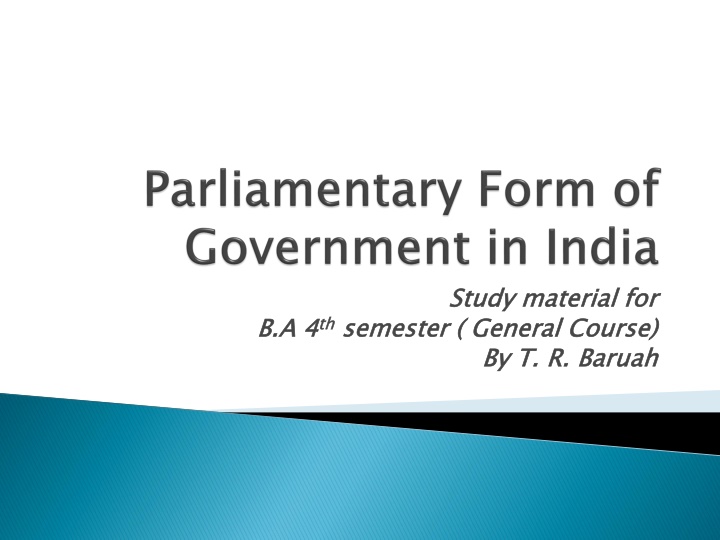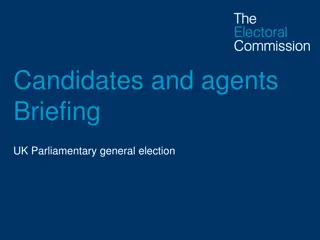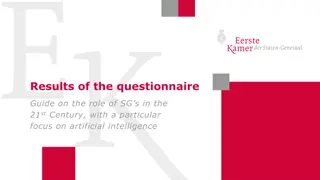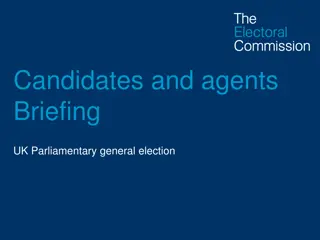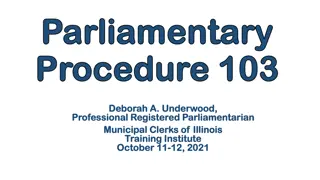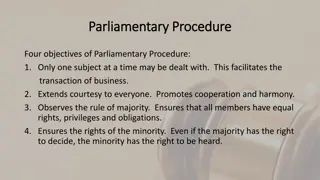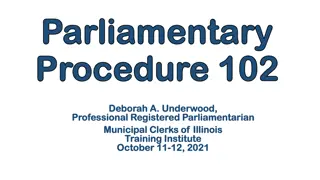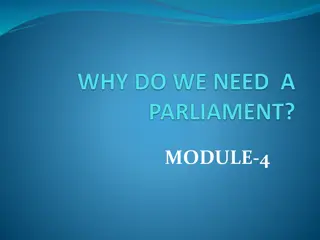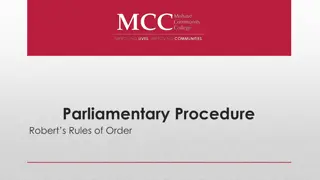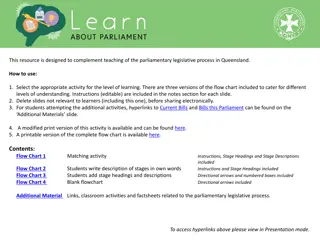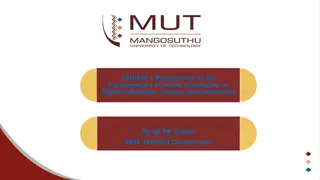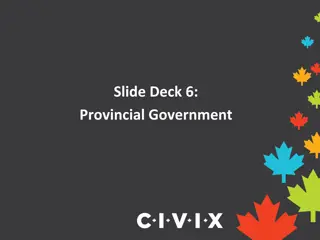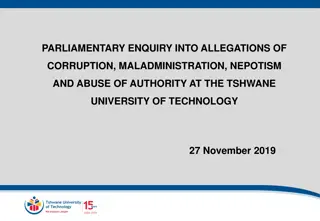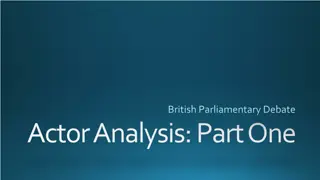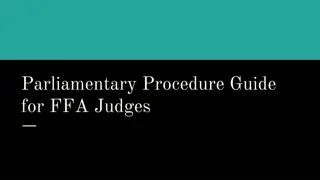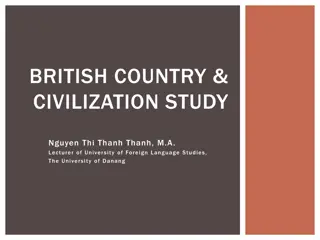Definition and Characteristics of Parliamentary Government
This content explores the definition and characteristics of parliamentary government, focusing on how power is vested in a formal head but exercised by popular ministers. It delves into the roles of nominal and real heads, the importance of the opposition party, and the composition of the Indian Parliament with its two houses, Council of States and House of the People.
Download Presentation

Please find below an Image/Link to download the presentation.
The content on the website is provided AS IS for your information and personal use only. It may not be sold, licensed, or shared on other websites without obtaining consent from the author.If you encounter any issues during the download, it is possible that the publisher has removed the file from their server.
You are allowed to download the files provided on this website for personal or commercial use, subject to the condition that they are used lawfully. All files are the property of their respective owners.
The content on the website is provided AS IS for your information and personal use only. It may not be sold, licensed, or shared on other websites without obtaining consent from the author.
E N D
Presentation Transcript
Study material for semester ( General Course) By T. R. Study material for B.A 4 B.A 4th thsemester ( General Course) By T. R. Baruah Baruah
Definition of Parliamentary Government : Parliamentary form of government may be defined as a government in which power is vested in a formal head but in actual practice it is exercised by popular ministers who are the members of the legislature. It is also called Cabinet Government because the cabinet which consists of ministers rules the country. Definition of Parliamentary Government : England is the ancestral home of this form of government. British parliament is the oldest parliament of the world. Characteristics of Parliamentary Government 1. Existence of two heads- nominal head and the real head or the head of the state and the head of the government. 2.Nominal Head may be a queen, king or president and Real Head is the Prime Minister(Union Council of Ministers headed by the Prime Ministers). 3. The ministry is responsible to the legislature . Lower house of the legislature can remove it from power. Characteristics of Parliamentary Government:
4. Opposition party is indispensable . 5. Ministers are collectively responsible for conducting the administration of the country. 6.The Ministry remains in office on the support of majority of the members of the lower house of the legislature. 7.Generally the ministry is a homogeneous body that means they belong to the same party. All the above mentioned features are available in India. 1.There are two heads in India- President is the nominal executive and Prime Minister along with his cabinet members are real executive. 2.Union cabinet in India is responsible to the lower house of the parliament that is the Lok Sabha . 3.In India also Opposition party plays very important role. 4. In India also Ministry is homogeneous and all the members of the present cabinet belong to BJP. 5.Ministers are collectively responsible for running the administration of the country.
Composition of Indian Parliament 1.Indian Parliament consists of President and the two houses known as Council of States (Rajya Sabha) and House of the People (Loksabha). 2.The President is an integral part of the legislature but he is not a member of either of the houses. 3.He summons and prorogues the parliament and without his signature no bill can be passed by the parliament. 4. The total strength of Rajya Sabha is 250 out of which 12 are nominated by the President. Total strength of Lok Sabha is 547 out of which 525 are elected from the states 20 from the union territories and 2 are nominated by the President from among Anglo Indian communities. 5.Rajya Sabha is a permanent chamber and it is not subject to dissolution.1/3 rd of its member retire after every two years.Thus the members enjoy a term of six years. 6.Normal term of Lok Sabha is 5 years. The President has the power to dissolve it at any time. 7. Vice President of India is the ex-officio chairman of the Rajya Sabha. 8. There is a Speaker of the Loksabha who is elected by the members from among themselves. Composition of Indian Parliament:
The functions of the houses 1.The principal function of the Lok Sabha and the Rajya Sabha is to make laws . Jointly they participate in making laws on all matters which have been mentioned in the Union list and the Concurrent list. 2. A money bill can originate only in the Lok Sabha but a non money bill can originate in either of the houses. 3. If there is any conflict between the two houses on non monetary matters it can be solved by a joint session. 4.An amendment bill to amend the constitution may originate in either of the houses. 5.Both the houses enjoy equal authority in the election of the President and the Vice President and also in the removal of the President, Vice President Chief Justice , Judges of the Supreme Court and the High Courts. 6.In financial matters Lok Sabha has exclusive control over the national purse. 7. The Rajya Sabha alone can initiate measures for removing the vice president o f India. 8. The Lok Sabha may remove the Union Council of Ministers by adopting a no confidence motion. The functions of the houses:
The Lok Sabha is the mouth piece of the people of India . As its members are directly elected by the people ,it is the representative chamber of the people it is called the popular chamber. The framers of the constitution have deliberately given less powers to the Rajya Sabha to make Lok Sabha more powerful as it is a parliamentary form of government. Conventionally lower house should be more powerful than the upper house in a Parliamentary system of government. The members of the Rajya Sabha are send by the states and the Union Territories on the basis of their population. Rajya Sabha can maintain the continuity of legislation as it is a permanent chamber. of Ministers. It can keep the government in the right path. It can make and unmake the Council of Ministers as the former is responsible to it. The members of the Lok Sabha may put pressure upon the Government to work for the welfare of the people.They may point out the difficulties of the people in the House. The Lok Sabha has complete control over the Council
At last it can be said that it is true that the Lok Sabha is very powerful in all respects but it is the two houses together that is the Parliament of India. If we make a critical study of the working of the parliament in India, it makes it clear that though Lok Sabha is more powerful in some matters but Rajya Sabha is also not totally an ornamental chamber. For the true success of the system both the houses must act harmoniously. Thank You
